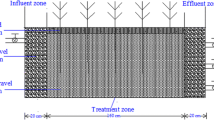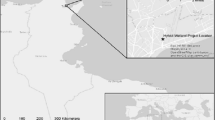Abstract
Two identical experimental subsurface-flow constructed wetlands were operated at relatively high organic loading rates (23 g COD m−2 day−1) for 4 months to evaluate their relative ability to remove either dissolved organic carbon (glucose, considered to be a readily biodegradable substrate) or particulate organic carbon (starch, considered to be a slowly biodegradable substrate). The systems were built using plastic containers (0.93 m long, 0.59 m wide and 0.52 m high) that were filled with an 0.35 m layer of wetted gravel (D60 = 3.5 mm, uniformity coefficient Cu = D60/D10 = 1.7) and the water level was maintained at 0.05 m under the gravel surface to give a water depth of 0.30 m. The results indicated that there was no significant difference in COD removal between the two systems. Both systems generally had COD removal rates of over 90%, which is quite high if the heavy load applied is taken into account. The removal of ammonium was greater in the glucose-fed system (57%) in comparison with the starch-fed system (43%). Based on mass balance calculations and stoichiometric relationships, it was estimated that denitrification and sulphate reduction were minor pathways for the removal of organic matter. Indirect observations allowed to assume that methanogenesis made a highly significant contribution to the removal of organic matter.




Similar content being viewed by others
References
AGBAR. (2004). Aigües de Barcelona. Internal technical report. Barcelona, Spain. (In Catalan).
Aguirre, P., Ojeda, E., García, J., Barragán, J., & Mujeriego, R. (2005). Effect of water depth on the removal of organic matter in horizontal subsurface flow constructed wetlands. Journal of Environmental Science and Health, 40, 1457–1466.
APHA-AWWA-WPCF. (2001). Standard methods for the examination of water and wastewater (20th ed.). Washington, DC: American Public Health Association.
Baptista, J. D. C., Donnelly, T., Rayne, D., & Davenport, R. J. (2003). Microbial mechanisms of carbon removal in subsurface flow wetlands. Water Science and Technology, 48(5), 127–134.
Burgoon, P. S., Reddy, K. R., & Debusk, T. A. (1995). Performance of subsurface flow wetlands with batch-load and continuous-flow conditions. Water Environment Research, 67, 855–862.
Caselles-Osorio, A., & García, J. (2006). Performance of experimental horizontal subsurface flow constructed wetlands fed with dissolved or particulate organic matter. Water Research, 40, 3603–3611.
Caselles-Osorio, A., & García, J. (2007). Effect of physico-chemical pretreatment on the removal efficiency of horizontal subsurface-flow constructed wetlands. Environmental Pollution, 146, 55–63.
Cooper, P. A., Job, G. D., Green, M. B., & Shutes, E. B. E.(Eds.) (1996). Reed beds and constructed wetlands for wastewater treatment. Swindon, UK: WRc Publications.
García, J., Aguirre, P., Barragán, J., Mujeriego, R., Matamoros, V., & Bayona, J. M. (2005). Effect of key design parameters on the efficiency of horizontal subsurface flow constructed wetlands. Ecological Engineering, 25, 405–418.
García, J., Aguirre, P., Mujeriego, R., Huang, Y., Ortiz, L., & Bayona, J. M. (2004a). Initial contaminant removal performance factors in horizontal flow reed beds used for treating urban wastewater. Water Research, 38, 1669–1678.
García, J., Chiva, J., Aguirre, P., Alvarez, E., Sierra, J. P., & Mujeriego, R. (2004b). Hydraulic behaviour of horizontal subsurface flow constructed wetlands with different aspect ratio and granular medium size. Ecological Engineering, 23, 177–187.
Guellil, A., Thomas, F., Block, J. C., Bersillon, J. L., & Ginestet, P. (2001). Transfer of organic matter between wastewater and activated sludge flocs. Water Research, 35, 143–150.
Hammes, F., & Verstraete, W. (2002). Key roles of pH and calcium metabolism in microbial carbonate precipitation. Reviews in Environmental Science & Biotechnology, 1, 3–7.
Kadlec, R. H. (2003). Effects of pollutant speciation in treatment wetlands design. Ecological Engineering, 20, 1–16.
Kadlec, R. H., & Knight, R. L. (1996). Treatment wetlands (p. 893). Boca Raton, FL: CRC Press.
Langergraber, G., Harberl, R., Laber, J., & Pressl, A. (2003). Evaluation of substrate clogging processes in vertical flow constructed wetlands. Water Science and Technology, 48(5), 25–34.
Marani, D., Renzi, V., Ramadori, R., & Braguglia, C. M. (2004). Size fractionation of COD in urban wastewater from a combined sewer system. Water Science and Technology, 50(12), 79–86.
Martín, M. (1983). Primary components of the hydrologic cycle. In E. Custodio & M. R. Llamas (Eds.), Underground hydrology (pp. 281–350). Barcelona: Omega, (In Spanish).
McCracken, K. L., McDowell, W. H., Harter, R. D., & Evans, C. V. (2002). Dissolved organic carbon retention in soils. Comparison of solution and soils measurements. Soil Science Society of America Journal, 66, 563–568.
Mino, T., San Pedro, D. C., & Matsuo, T. (1995). Estimation of the rate of slowly biodegradable COD (SBCOD) hydrolysis under anaerobic, anoxic and aerobic conditions by experiments using starch as model substrate. Water Science and Technology, 31(2), 95–103.
Platzer, C., & Mauch, K. (1997). Soil clogging in vertical flow reed beds – Mechanisms, parameters, consequences and solutions? Water Science and Technology, 35(5), 175–181.
Reddy, K. R., & D’Angelo, E. M. (1997). Biogeochemical indicators to evaluate pollutant removal efficiency in constructed wetlands. Water Science and Technology, 35(5), 1–10.
Speece, R. E., Duran, M., Demirer, G., Zhang, H., & DiStefano, T. (1997). The role of process configuration in the performance of anaerobic systems. Water Science and Technology, 36(6–7), 539–547.
USEPA. (2000). Constructed wetland treatment for municipal wastewater, 166 pp. EPA/625/R-99/010. Cincinnati, OH: Office of Research and Development.
Wiessner, A., Kappelmeyer, U., Kunschk, P., & Kästner, M. (2005). Sulphate reduction and the removal of carbon and ammonia in a laboratory-scale constructed wetland. Water Research, 39, 4643–4650.
Acknowledgements
The authors wish to express their gratitude to Emma Segú, Ana Pedescoll, Cristina Ramos and Eduardo Álvarez for their kind and invaluable help in the experimental work. The results of this study were obtained thanks to a grant awarded by the Spanish Department of Education and Science, research project REN2002-04113-C03-03. The first author wishes to thank the University of the Atlantic (Colombia) for the grant to carry out PhD studies in Spain.
Author information
Authors and Affiliations
Corresponding author
Rights and permissions
About this article
Cite this article
Caselles-Osorio, A., Porta, A., Porras, M. et al. Effect of High Organic Loading Rates of Particulate and Dissolved Organic Matter on the Efficiency of Shallow Experimental Horizontal Subsurface-flow Constructed Wetlands. Water Air Soil Pollut 183, 367–375 (2007). https://doi.org/10.1007/s11270-007-9385-1
Received:
Accepted:
Published:
Issue Date:
DOI: https://doi.org/10.1007/s11270-007-9385-1




